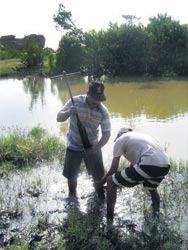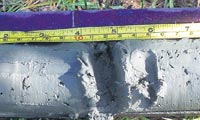
Dredging out past tsunamisTwo major tsunamis or storms had hit Kirinda 2,200 years and 1,600 years ago, a team of scientists have discovered through dating layers of sand deposits from the estuary in Kirinda.
As night envelopes Hambantota, three men clad in shorts wade into the Kirinda estuary and in the subdued red glow of a torch, with feet squelching mud, press a long pipe deep into the depths of the estuary bed. Collecting three metres of sediment, with a “corer” they tenderly lift it out and pack the contents into S-lon tubes, “like making pittu”, still working in the dim torchlight, to which the eyes have to take about half-an-hour to adjust. The process is repeated and several sediment samples well-wrapped in black polythene, so as not to expose the contents to light, are transported to Colombo.
As they study the samples once again in dim light, in the laboratory of the Central Cultural Fund, the excitement is tangible. Yes, the layers were visible. Amidst the mud were three clear layers of sand, says Dr. Mohan Abeyratne, the Director of Scientific Research of the Central Cultural Fund (CCF). It was a tsunami study of a different kind that the CCF team comprising Dr. Abeyratne and Research Scientist (Geology), Pathmakumara Jayasingha and Ashok Kumara of the Post-Graduate Institute of Archaeology, were carrying out. “The objectives of the study were two fold. The first was to locate deposits from the most-recent 2004 tsunami and the second was to find deposits if available of any other tsunamis or large storms which may have occurred in and around Kirinda in ancient times,” explains Dr. Abeyratne pointing out that historical records suggest at least one catastrophic tsunami did take place in the area. And the technique used by the CCF team is thermo-luminescence (TL) dating. According to Dr. Abeyratne, whose speciality is dating of the archaeology type, a TL dating laboratory was established at the CCF way back in 1985. “This one and only dating lab in Sri Lanka even now, was set up to scientifically date archaeological objects such as pottery, bricks etc.” In addition to ascertaining whether Sri Lanka experienced Paleotsunamis, as tsunamis in ancient times are dubbed, Dr. Abeyratne says that their study was also to check out the recurrence and timing of not only tsunamis but also bad storms. “This will help us to predict such catastrophes,” he says Explaining the principle on which their scientific studies are carried out, he says: “A tsunami or big storm would bring with its waters sediment from the seabed and deposit it on land. Depending on the size or energy of the waves, the amount and thickness of the sediment deposited will vary. With time, these deposits will get covered by more sediment either wind-blown or brought in by the normal waves. However, such deposits from tsunamis or storms would be well preserved in calm coastal environments such as lagoons and estuaries.”
And that’s why when the team was chatting to the owner of a tea kiosk while having breakfast that they were pointed to the Kirinda estuary and picked on it eagerly. The major difference between sediment deposit from a tsunami, triggered by an earthquake, and a storm would be the extent of their reach. A powerful tsunami would deposit sediment a lot more inland than a storm, says Dr. Abeyratne. “Comparing past seismic events (such as earthquakes) with past tsunamis might be able to establish a relationship of the rate of seismic activities and their devastating results, which may finally help us to predict any future tsunami.” Adds Mr. Jayasingha that another crucial difference would be the fact that in a tsunami there would be many waves (run-up) lashing the shore unlike in a storm. “Meanwhile, a tsunami would also have a backwash, sometimes faster than the run-up which would take back some of the sediment with it.” According to Mr. Jayasingha tsunami deposits may be distinguished from river deposits by “biological markers, spatial distribution, sediment characteristics and geo-chemistry”.“Tsunami deposits have marine or brackish water fossils such as shells or diatoms while river deposits would have freshwater varieties. Geochemical indicators in tsunami deposits will be bromine, sodium and calcium,” he explains. Although, TL dating has been widely applied in archaeology and prehistory it has been only used once to date tsunami generated sediments, The Sunday Times learns. So what were the findings on the dating carried out at the CCF lab and analysis under the supervision of Prof. R. Hewamanna and Prof. P. Mahawatte at the Colombo University’s Department of Nuclear Science, of the sand deposits from the estuary in Kirinda? Two major tsunamis or storms did hit Kirinda 2,200 years and 1,600 years ago, The Sunday Times learns. This reinforces the famous story handed down from generation to generation and also mentioned in the Mahavamsa of how the sea overflowed the land and of Vihara Maha Devi being washed ashore down south. The rock that villagers say marks the spot she came ashore is quite close to the Kirinda estuary, adds Dr. Abeyratne.
|
|| Front
Page | News | Editorial | Columns | Sports | Plus | Financial
Times | International | Mirror | TV
Times | Funday
Times || |
| |
Copyright
2007 Wijeya
Newspapers Ltd.Colombo. Sri Lanka. |

